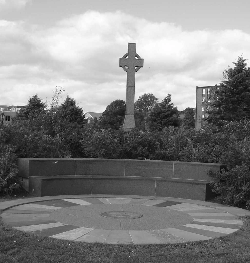Irish settler memorial at Charlottetown,
Prince Edward Island.
With its semi-feudal land system Prince Edward Island was less appealing than
the other provinces. While settlers could acquire leaseholds from landlords, they could not easily purchase land, causing many Irish to bypass it all together or to eventually leave. As a result, the
island became a well-trodden staging post for people seeking onward settlement in other parts of the Maritimes.
Situated opposite New Brunswick and Nova Scotia and within easy reach of
Newfoundland, Prince Edward Island occupies a strategic location in the Gulf of St Lawrence. Shipping routes, used to transport goods, also served Irish fishery workers in Newfoundland who moved to
Prince Edward Island from the late eighteenth century to take up farming or better-paid jobs. They were Catholics who had mainly originated from counties Wexford, Waterford, Carlow, Kilkenny and
Tipperary in the south east of Ireland.
Later on, many of the Irish, who had settled in Prince Edward Island, were
driven by similar motives of self-betterment. They hopped on vessels that regularly crossed to the Miramichi region of New Brunswick. Thus, the island effectively became a crossroads for Irish people
who, either arrived from Newfoundland, or went on to New Brunswick to benefit from its timber trade.
The situation changed in the 1830s when a Catholic priest organized the
departures of over 2,000 Irish people, originating mainly from County Monaghan, who were then residing in Glasgow.
Taking pity on the many poor Irish people who were living in Glasgow, Father
MacDonald organized their departures to the island. They mainly settled in central Queens County and along the boundaries between Queens and Prince Counties and Queens and Kings Counties, these being
the areas where they could most easily find sufficient land to form their communities.


